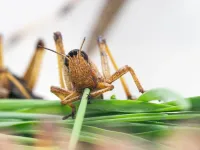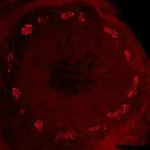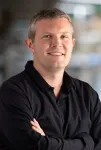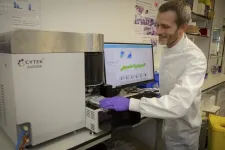(Press-News.org) The migratory locust Locusta migratoria is an economically important crop pest that is said to have come to Egypt in the Old Testament as the eighth of the ten biblical plagues, "to devour all that plants that grow". The migratory locust is rarely found in Europe, but in Africa and Asia it not only causes millions of dollars’ worth of damage but also has a deadly impact on local people, threatening their food and their very existence. The locusts occur in two phases: as solitary animals and in swarms. The insects are most feared when they appear in large swarms and destroy entire harvests.
Migratory locusts differ from other insects in the anatomical structure of their olfactory brain, the antennal lobe, which receives and processes olfactory information from the antenna. The locust antennal lobe has a unique and unconventional neuronal architecture with more than 2000 spherical functional olfactory units, the glomeruli, whereas most other insects have only between 20 and 300 glomeruli in the antennal lobe.
Scientists at the Max Planck Institute for Chemical Ecology are interested in how insects perceive odors and process them in their brains. Above all, however, they want to know how odor perception affects their behavior.
"Our goal was to solve the long-standing puzzle of how odors are encoded in the extremely large population of glomeruli, the structural and functional units in the antennal lobe of migratory locusts. This highly complex architecture of the locust antennal lobe has been observed for decades, but the underlying mechanisms of odor coding have remained a mystery due to the lack of suitable methods," says Xingcong Jiang, first author of the study.
The introduction of the CRISPR/Cas9 method represented a methodological breakthrough for the researchers, as it enabled the establishment of the first transgenic migratory locusts expressing the genetically encoded calcium sensor GCaMP in olfactory sensory neurons. GCaMP is a protein that fluoresces when it binds calcium, which is released into cells when they are active. Using functional 2-photon calcium imaging, the scientists were able to measure and map the spatial activation patterns for a broad spectrum of ecologically relevant odors in all six developmental stages of the migratory locust.
"Our results reveal an unusual functional ring-shaped organization of the antennal lobe consisting of specific glomerular clusters. This glomerular arrangement, which we could confirm by targeted genetic expression of a well-characterized olfactory receptor, is present throughout development, and the pattern of olfactory coding within the glomerular population is consistent at all developmental stages, from the first nymph stage to the adult locust,” summarizes Silke Sachse, head of the Olfactory Coding Research Group at the Max Planck Institute, one of the study leaders.
The migratory locust is not a model organism like the vinegar fly Drosophila melanogaster. Gene transformation was therefore a major challenge for the researchers. Many parameters have to be studied, which makes the process very time-consuming. The unusually large brain volume of the locust also makes it difficult to capture and analyze image data. "We are the first group in the world to successfully apply the site-specific knock-in method to locusts. We know from the literature that the success rate for this type of transgenesis is very low, but we have succeeded," says Xingcong Jiang.
Interestingly, the spatial coding of odors in the locust antennal lobe reflects the chemical structure of the odors rather than their valence - whether pleasant or repulsive - unlike in flies, for example, where the valence of odors is already represented in the antennal lobe, with pleasant odors activating different structures than unpleasant ones. "We have observed that odors of certain chemical classes evoke a certain pattern: For example, aromatic compounds with similar chemical structure but opposite behavioral significance evoke stronger responses in the peripheral regions of the antennal lobe. We conclude that the representation of odor valence is not encoded in the antennal lobe, but in higher brain centers such as the mushroom body and the lateral horn," says Bill Hansson, Director of the Department of Evolutionary Neuroethology, and one of the lead authors.
The ring structure of the olfactory code is a unique anatomical feature of the migratory locust. However, this coding mechanism is not necessarily transferable to other locust species. "We wonder whether this ring-shaped structure is a worse alternative or a better solution with advantages over the glomerular arrangement we found in flies. Future studies investigating the rules of odor coding in other insect species will show whether other locust species have developed a similar coding pattern," says Silke Sachse, who already has further studies in mind.
How insects perceive and process odors and how odor perception ultimately affects their behavior is important for a deeper understanding of the ecological interactions of insects with their environment. This can, for example, help to optimize the control of crop pests such as migratory locusts. "We believe that a better understanding of the odor coding mechanisms in the primary olfactory center of the locust brain will significantly deepen our knowledge of the neuronal modulation underlying olfaction-mediated behaviors, such as the formation of locust swarms," says Bill Hansson.
END
Odors are encoded in rings in the brain of migratory locusts
Researchers in Jena show that chemical information is represented completely differently in the brains of these insects than in other insects or vertebrates
2024-06-18
ELSE PRESS RELEASES FROM THIS DATE:
New global research aims to improve survival rates for pancreatic cancer patients
2024-06-18
A new study published today in JAMA Network Open by an international cohort of researchers provides the latest data on the effectiveness of treating pancreatic cancer patients with chemotherapy (with or without radiation therapy) before surgery to remove a tumor. The study focuses specifically on pancreatic adenocarcinoma patients.
The research found that after treatment and surgery, nearly five percent of patients had no detectable cancer cells left in the area where the tumor was, achieving a pathological complete response (pCR).
“PCR means that the cancer has responded extremely well to the treatment, leaving no ...
Medication treatment for opioid use disorder offered at only a third of outpatient mental health facilities
2024-06-18
Only a third of outpatient community mental health treatment facilities in 20 states with the highest opioid related overdose deaths report offering medication treatment for opioid use disorders, suggesting efforts may be needed to strengthen such services, according to a new RAND study.
Among the 450 clinics surveyed, factors that increased the likelihood that clinics would provide medication for opioid use disorders included being a certified behavioral health clinic and providing integrated mental and substance use disorder treatment.
Researchers found that most clinics that did not offer medication treatment said they referred patients to other clinics for ...
Salk scientist Jesse Dixon named 2024 Pew Biomedical Scholar
2024-06-18
LA JOLLA (June 18, 2024)—Salk Institute Assistant Professor Jesse Dixon has been named a 2024 Pew Biomedical Scholar by The Pew Charitable Trusts. This honor provides funding to early-career investigators who demonstrate outstanding promise in science toward advancing human health. Dixon and the other 21 awardees will each receive $300,000 over four years to support their research.
“Through his development and use of leading-edge genetic tools, Jesse has already made a major impact on how we study diseases such ...
Pew supports 22 researchers leading scientific innovation
2024-06-18
PHILADELPHIA—The Pew Charitable Trusts today announced the 22 researchers who have been selected to join the Pew Scholars Program in the Biomedical Sciences. These early-career scientists will receive four years of funding to explore some of the most pressing questions in human health and medicine.
“Pew believes that supporting promising early-career researchers is key to scientific innovation, and for nearly 40 years our scholars have helped change the world—creating lifesaving therapies and responding to emerging health crises around the globe,” ...
Discovery of ‘new rules of the immune system’ could improve treatment of inflammatory diseases, say scientists.
2024-06-18
Scientists at the University of Cambridge have discovered that a type of white blood cell - called a regulatory T cell - exists as a single large population of cells that constantly move throughout the body looking for, and repairing, damaged tissue.
This overturns the traditional thinking that regulatory T cells exist as multiple specialist populations that are restricted to specific parts of the body. The finding has implications for the treatment of many different diseases – because almost all diseases and injuries trigger the body’s immune system.
Current anti-inflammatory drugs treat the whole ...
5 Pew-Stewart Scholars chosen to advance innovative cancer research
2024-06-18
PHILADEPHIA—The Pew Charitable Trusts and the Alexander and Margaret Stewart Trust announced today the 2024 class of the Pew-Stewart Scholars for Cancer Research, five early-career scientists who will each receive four-year grants to explore new avenues in cancer development, diagnosis, and treatment. This is the 11th year the Alexander and Margaret Stewart Trust has partnered with Pew to cultivate a legacy of cutting-edge cancer research.
“Despite decades of groundbreaking research and innovative breakthroughs, millions of Americans are still all too familiar with the devastation and uncertainty of a cancer diagnosis,” ...
Pew funds 10 Latin American scientists conducting biomedical research
2024-06-18
PHILADELPHIA—The Pew Charitable Trusts today announced the 2024 class of the Pew Latin American Fellows Program in the Biomedical Sciences.
The 10 postdoctoral fellows from six Latin American countries—Argentina, Brazil, Chile, Cuba, Mexico, and Peru—will receive two years of funding to conduct research in laboratories across the United States. They will work under the mentorship of prominent biomedical scientists, including alumni from the Latin American fellows program and the Pew Scholars Program in the Biomedical Sciences.
“The grave threats to human health over the past few years—from COVID-19 to growing rates of cancer in younger adults—underscore ...
Accelerating drug discovery with the CCDC, AWS, and Intel
2024-06-18
Thanks to the combined computing power of Amazon Web Services (AWS) and Intel, the CCDC announces that a potentially significant advancement in drug discovery has been achieved. A curated data set of protein structures from the Protein Data Bank (PDB) with predicted hydrogen positions is now available for download. This project was supported by an Intel RISE Technology Initiative contribution.
Historically, collaborations with the pharmaceutical industry have enabled the development of reliable methods for interpreting interactions within protein binding sites using proprietary information not publicly available. Repeating these studies ...
Updates from the 2022 WHO classification of kidney epithelial tumors
2024-06-18
Renal tumor pathology has evolved considerably, expanding from two main types of renal malignant tumors to over 20 distinct types. Diagnostic criteria have advanced from purely morphological features to include histochemistry, immunohistochemistry (IHC), and molecular genetics. The World Health Organization (WHO) and the International Society of Urologic Pathology (ISUP) have been instrumental in updating these criteria, resulting in a comprehensive framework essential for accurate diagnosis, effective treatment, and improved patient outcomes.
The field of renal tumor pathology has undergone ...
Interdisciplinary team at MUSC Hollings Cancer Center maps role of P. gingivalis in drug resistance
2024-06-18
A new paper from an interdisciplinary team at MUSC Hollings Cancer Center describes how the bacteria Porphyromonas gingivalis interferes with chemotherapy-induced mitophagy, allowing oral cancer tumors to become resistant to the drug’s effects.
Besim Ogretmen, Ph.D., SmartState Endowed Chair in Lipidomics and Drug Discovery in the College of Medicine, and Ӧzlem Yilmaz, D.D.S., Ph.D., a professor, clinician-scientist and microbiologist in the College of Dental Medicine, worked with graduate ...
LAST 30 PRESS RELEASES:
UVA’s Jundong Li wins ICDM’S 2025 Tao Li Award for data mining, machine learning
UVA’s low-power, high-performance computer power player Mircea Stan earns National Academy of Inventors fellowship
Not playing by the rules: USU researcher explores filamentous algae dynamics in rivers
Do our body clocks influence our risk of dementia?
Anthropologists offer new evidence of bipedalism in long-debated fossil discovery
Safer receipt paper from wood
Dosage-sensitive genes suggest no whole-genome duplications in ancestral angiosperm
First ancient human herpesvirus genomes document their deep history with humans
Why Some Bacteria Survive Antibiotics and How to Stop Them - New study reveals that bacteria can survive antibiotic treatment through two fundamentally different “shutdown modes”
UCLA study links scar healing to dangerous placenta condition
CHANGE-seq-BE finds off-target changes in the genome from base editors
The Journal of Nuclear Medicine Ahead-of-Print Tip Sheet: January 2, 2026
Delayed or absent first dose of measles, mumps, and rubella vaccination
Trends in US preterm birth rates by household income and race and ethnicity
Study identifies potential biomarker linked to progression and brain inflammation in multiple sclerosis
Many mothers in Norway do not show up for postnatal check-ups
Researchers want to find out why quick clay is so unstable
Superradiant spins show teamwork at the quantum scale
Cleveland Clinic Research links tumor bacteria to immunotherapy resistance in head and neck cancer
First Editorial of 2026: Resisting AI slop
Joint ground- and space-based observations reveal Saturn-mass rogue planet
Inheritable genetic variant offers protection against blood cancer risk and progression
Pigs settled Pacific islands alongside early human voyagers
A Coral reef’s daily pulse reshapes microbes in surrounding waters
EAST Tokamak experiments exceed plasma density limit, offering new approach to fusion ignition
Groundbreaking discovery reveals Africa’s oldest cremation pyre and complex ritual practices
First breathing ‘lung-on-chip’ developed using genetically identical cells
How people moved pigs across the Pacific
Interaction of climate change and human activity and its impact on plant diversity in Qinghai-Tibet plateau
From addressing uncertainty to national strategy: an interpretation of Professor Lim Siong Guan’s views
[Press-News.org] Odors are encoded in rings in the brain of migratory locustsResearchers in Jena show that chemical information is represented completely differently in the brains of these insects than in other insects or vertebrates






